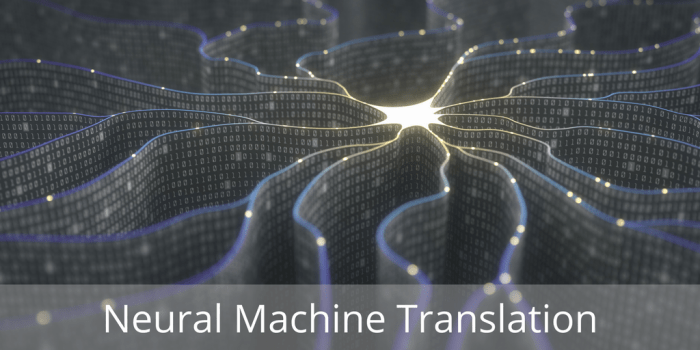Translation holds power over the business world. The mere fact that a change of language can bring in the audience is a game-changer. It is fascinating to be bilingual or even multilingual and each language adds to the opportunities of business growth. Imagine If you didn’t have to do it all by yourself, how would you feel then?
As technology keeps progressing, we cannot deny the urge to explore how far we can go with artificial intelligence. The use of technological tools for translation is quite expensive and time-consuming but it is quite a handy tool. Speaking of modern tools, translation has evolved over the years. It’s not just human or standard machine translation anymore, now we are introduced to the age of Neural Machine Translation (NMT).
Artificial Intelligence Gives Birth to New Generation of Translation
The localization industry relies heavily on a combination of human translation and machine translation. However, with time, demand increases and to develop a more steady growth of the industry, Neural Machine Translation came in, with aim of low cost and high work efficiency it may be the best hybrid answer so far.
In the domain of Neural Machine Translation, exploring the array of tools for translation is paramount. These tools encompass a spectrum of functionalities, from enhancing linguistic accuracy to streamlining the translation process. Understanding the nuances of these tools can significantly amplify the efficacy of NMT systems.
Before you run into conclusions of how magnificent the NMT is, it is time for a brief learning lesson.
Growth of Neural Machine Translation
It is not so different from machine translation however, it does represent an edge. An end to end automated translation that overcomes the standard translation version is what neural machine translation is all about.
The translation results are super accurate comparatively to its predecessor and allow categorizing according to usage. Comprised of existing bilingual databases, NMT is an automated learning process. It is fast, efficient, and brings an improved quality of translation.
How NMT differentiates from Rule-Based machine Translation (RMBIT) and Statistical Machine Translation (SMT)?
- Rule-based machine translation is based on the use of grammar rules using specific dictionaries.
- Statistical machine translation uses statistical models based on the analysis of multilingual content databases.
Comparatively to these two types of machine translation, NMT has a simpler structure. You can expect three major changes by using this version for translation;
- Raw machine translation
- Expectations: you can obtain control of text for internal use quickly.
- Recommended use: best for technical content
- Light post-editing
- Expectations: to get large volumes of content in a shorter period.
- Recommended use: best for internal communication, reports on technical content, and controlled language.
- Full post-editing
- Expectations: you can get a high-quality translation for published content.
- Recommended use: best for official documents like catalogs and annual reports.
Achievements of Neural Machine Translation
Every machine translation has its limitations. For machine translation it is impossible to translate raw data, a text must be organized for any type of machine translation to work.
- Levels of automation
Upgraded features make translation easier and enable you to learn statistical models using specific algorithms for translation. A continuous translation output has shown effective results, especially for the technical terminologies.
- Applicable for most languages
It is rather beneficial to use NMT for rare source languages as well. It bridges the gap between the source language and the target language. The language combinations result in effective local dependencies, word alignment, and sentence order. This way you can avoid using multiple translation software.
- Better fluency
The higher the inter-system variability is, the more effectively fluent the results will be. The use of syntax, morphology, reordering, and agreements will be outperformed by NMT. It depicts the encoding and uses future suggestions for references, making it a more reliable source.
- Effective end to end approach
As explained above, NMT focuses on end to end approach; it maximizes the translation quality in the target language. NMT relies on the sequence model, which helps in the fluency of the translated content.
Neural Machine Translation is not the Offspring of Google Translate!
One of the major misconceptions regarding machine translation is that we think every discovery or invention in the localization industry is because of Google. It is not true.
The professional translation service providers do provide customized translation engines, trained for the optimized use for specific requirements of projects. But the neural machine translation’s output depends on the source of content, what type it is, and so on.
Therefore, the best way to get high-quality translation results is to focus on the style, characteristics, and quality of the source content. For a translation provider to effectively use NMT means they need to analyze the documents and decide whether it is suitable for a machine translation or not.
If source content is of poor quality, nothing much can be done by the NMT. So the best remedy so far is to keep your sentences fort and use controlled language and also ensure you use standard terminologies.
Even Neural Machine Translation has its Limitations
More than often a machine translation’s efficiency slows down. Technically it doesn’t slow down but the user demand increases which creates a gap in the source content and the translated content.
- Although it is the most developed form of machine translation, it still objectifies to lexical limitations. It means there still is limited applicability for certain terms. It affects the accuracy and versatility of the translated content.
- Format limitation is yet another obstacle for all types of machine translations. An improper automated translation can also expose your confidential data.
- Even NMT is prone to short-term memory loss. The system needs constant updates and in the process, the stored information can be compromised.
- Even though it is currently the best source of machine translation, NMT is not 100% reliable. This is common, especially with odd language pairs.
Neural machine translation eases the workload but is prone to the issues. Artificial intelligence helps businesses to correspond in new ways to expand their brands overseas. So far with the potential benefits, NMT is a source of an idealistic translation, helps to make the localization process easier as a newfound technology.
If you think you are ready to find a linguistic partner that uses NMT as a part of its services, you ought to give it a try.







